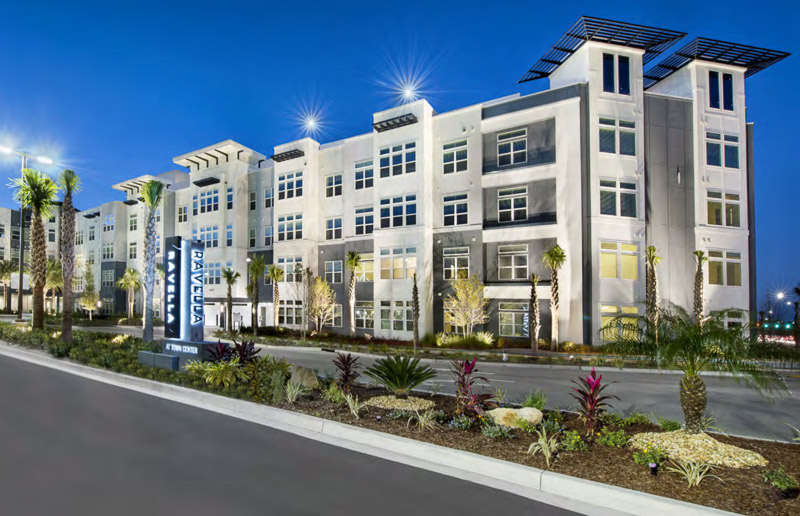Factors to Consider When Investing in Multifamily Properties
Investing in real estate areas like multifamily properties has historically been attractive to investors because of its historical relative stability to other asset classes and its potential for higher returns. Other asset classes like office, retail, and hospitality experienced significant problems during the pandemic; for instance, national office vacancy rates in Q2 2021 reached an overall average of 15.6% according to a 2021 Q1 Commercial Edge Report.
In contrast, US Multifamily properties had an average vacancy rate of 4.2%, according to the CBRE US Multifamily report Q1 2021. In a period of employment uncertainty and substantial economic changes, those figures support multifamily as a bastion of potential security.
Outlined below are primary factors analyzed when investing in a multifamily asset. Our investment team at Perch Wealth takes pride in thoroughly underwriting and evaluating potential investments, including Delaware Statutory Trust (DST) multifamily offerings; here is a peak into our assessment process.
Establish “As Is” Value & Going in “Cap Rate”
First and foremost, when looking at a new deal, we determine the “in-place cashflow” of the asset. The rent roll must be analyzed to determine the current in-place rents, occupancy, market rent, and concessions. Next we compare those numbers with the profit & loss statement to determine the in-place Net Operating Income (NOI) of the asset.
As analysts, we normally anticipate changes to the expenses when the asset is acquired, such as an increase to real estate taxes, payroll, insurance, or property management fees. Understanding how cashflows will adjust upon changes in ownership is key to establishing what the Month-1 income will likely be to then determine our going in “cap rate”. Once the adjusted NOI has been calculated, we can determine our expense-adjusted going in “cap rate” by dividing the adjusted NOI by our projected purchase price.
The going in “cap rate” is more important for core/core-plus asset classes where there is less opportunity to immediately increase NOI through adding value to the property. On value-add properties the “Stabilized Return on Cost” is a more important metric to determine, which is the stabilized NOI divided by the total basis in the property.
Going in “cap rates” will vary depending on the quality of the market and asset, where each property must be compared to other sales comparable “cap rates” to help affirm that the investor is making a good purchase.

Analyze Potential Value and Business Plan
Once the “as-is value” of a property has been determined, the potential of the property must be determined along with a business plan. For example, an older 80's vintage property that has not been upgraded, located near similar properties nearby that have undertaken renovations, would be attractive. If the comps are providing a premium in rents, there is an opportunity to potentially improve the property and charge higher rent, which in turn could increase our NOI and value of the asset.
When drafting the value-add business plan, an investor should consider how much they will spend to charge rental premiums for an improved rental product. The key metric to value this work is called “Return on Improvement Cost”. “Return on Improvement Cost” is calculated by taking the average post-improvement rent increase per unit annualized and dividing it by total improvement cost per unit.
For example, on a recent underwriting transaction by one of our analysts where the proposed spending was $16,358/unit in capital improvements to improve the interior units and common areas of a property, the business plan projected increasing rents $331 per month which equated to $3,729 of additional income per year. $3,729 divided by $16,358 equals a “Return on Improvement Cost” of 22.80%, which is a strong number that helped confirm the value of improving a property.
A good “Return on Improvement Cost” is generally around 18%-20%+, whereas lower numbers than that might not justify taking the time and effort to complete the job and risking additional capital on construction risk.
Savvy investors might also increase the NOI of a deal by improving the operations of a property. One might increase income by charging additional fees for things like pet yards, valet trash services, covered parking, amenity fees, or even laundry services. These help potentially increase top line revenue which in turn could increase NOI.
Expenses can also be optimized by reducing unnecessary services to the property, renegotiating landscaping contracts, installing low use water appliances which decreases water bills, installing LED lighting which decreases electricity bills, reducing payroll if possible, and in some markets, real estate bills can sometimes be challenged in court or with the county and reduced.
Small operating changes made to proper underwriting have the potential to add up and significantly increase returns through the hold period. An investor who digs in and makes the small improvements to operational underwriting could unlock hidden value in the property, afford to pay a higher price, and win bidding processes more often than groups who solely look at the historical operations of an asset.
Conduct Thorough Due Diligence and Capitalize for Deferred Maintenance
Whenever looking at a potential acquisition, it is important to conduct due diligence on the age and quality of the asset and the amount of capital that needs to be budgeted to anticipate repairing deferred maintenance during the hold period.
Primary considerations on a multifamily property deal include the age and quality of the roofs, the existence of poly piping, the existence of aluminum wiring, the age and condition of any elevators, condition of the parking lots, structural quality, age and condition of heating and cooling systems, and many other items. Prospective investors should adequately budget for anticipated capital improvements to the property which will affect how much they can afford to pay when they buy the property.
Choosing the Proper Financing
Different properties will require different types of debt financing to achieve the stated goals of the investment. If an investor anticipates a large capital budget and major revitalization project, they will probably have a tough time securing typical agency financing.
Typically, the best option would be a bridge execution provided by a debt fund. The benefits of going with bridge debt is the potential opportunity to increase leverage over the typical 75% LTV limits, floating rate debt, non-recourse money, and the ability to sell the asset within 3-5 years without a major pre-payment penalty.
Bridge lenders often allow high leverage/additional risk because they concur with the investor’s business plan and see the potential of the property to produce more income. The downside of going with these sort of lenders is that they are commonly more expensive; they will charge higher up front and back-end fees along with a higher interest rate to compensate for the additional risk.
When buying a stabilized core/core+ deal with a longer hold period than 3-5 years, it is generally a good idea to utilize an agency fixed rate deal because of the lower up-front costs and lower interest rates. The common downside to fixed rate agency financing is the lack of flexibility, as well as pre-payment penalties which can be financially burdensome.
If asset prices skyrocket 4 years into the 10-year agency debt term, the pre-payment penalty could be so significantly expensive that it does not make sense to sell, and the opportunity to take advantage of a heated sales environment is lost.

Hold Period, Exit Strategy, and Returns
The duration of the investment must also be considered when evaluating a potential multifamily properties investment. An investor must ask themselves what metrics are most important to them such as capital preservation, long term cashflow, high IRR, etc. If an investor cares about capital preservation, they would most likely purchase a Class-A stabilized asset with little deferred maintenance, put low leverage on the deal and underwrite a hold period of 10 years.
An investor who favors higher returns could buy a value-add property in a less desirable location, initially place bridge debt financing on the deal, seek to improve the property and increase NOI, and then attempt to refinance the property if it successfully stabilizes in year 3 or 4 and hold the deal 10 years in total for their underwriting purposes.
An investor who prefers a high IRR will search for properties with potentially unlocked value, place short term bridge debt, strive to expedite their business plan, and usually attempt to exit within 3-5 years.
When valuing assets on the front end, investors must always consider who is likely going to buy the property from them and why. Over-improving a property can sometimes be counter-productive. If an investor renovates 100% of an older property, their pool of potential buyers just became a lot smaller because “value add groups” will no longer look at it since there is no “meat left on the bone”.
Likewise, more conservative Class A buyers would likely not be interested, even though the property is now in good condition, because the vintage is just too old for them to stomach. An ideal exit strategy is to leave some potential upside on the asset which can cause future bidders to overpay you for the unrealized value.
The returns of a property should be differentiated by its class, location, and business plan risk. There are no hard and fast rules for these returns and these numbers are constantly changing as real estate cap rates have declined in the past 10 years and recently consolidated even further.
It seems that high level multifamily real estate deal returns should be broken into four categories, including core, core plus, value add, and development. Core deals should command 10-12% IRRs, core plus 13-15%, value add 17-19%, and development deals should underwrite to at least a 22% plus IRR.
Underwriting returns include relying on current data, operational expertise, opinion, and sometimes educated guessing. At Perch Wealth, our job is to analyze hundreds of deals per year, compare the different opportunities and choose what we believe to be the best risk-adjusted deals for our clients’ needs.
Contact Perch Wealth to find out how we might be able to help you assess and decide upon the 1031 exchange solution that we believe makes the most sense for you.
General Disclosure
Not an offer to buy, nor a solicitation to sell securities. Information herein is provided for information purposes only, and should not be relied upon to make an investment decision. All investing involves risk of loss of some or all principal invested. Past performance is not indicative of future results. Speak to your finance and/or tax professional prior to investing.
Securities offered through Emerson Equity LLC Member: FINRA/SIPC. Only available in states where Emerson Equity LLC is registered. Emerson Equity LLC is not affiliated with any other entities identified in this communication.
1031 Risk Disclosure:
• There is no guarantee that any strategy will be successful or achieve investment objectives;
• Potential for property value loss – All real estate investments have the potential to lose value during the life of the investments;
• Change of tax status – The income stream and depreciation schedule for any investment property may affect the property owner’s income bracket and/or tax status. An unfavorable tax ruling may cancel deferral of capital gains and result in immediate tax liabilities;
• Potential for foreclosure – All financed real estate investments have potential for foreclosure;
• Illiquidity – Because 1031 exchanges are commonly offered through private placement offerings and are illiquid securities. There is no secondary market for these investments.
• Reduction or Elimination of Monthly Cash Flow Distributions – Like any investment in real estate, if a property unexpectedly loses tenants or sustains substantial damage, there is potential for suspension of cash flow distributions;
•Impact of fees/expenses – Costs associated with the transaction may impact investors’ returns and may outweigh the tax benefits




